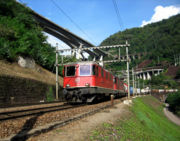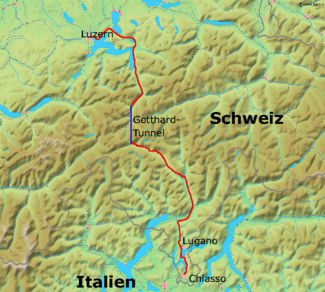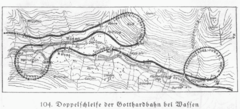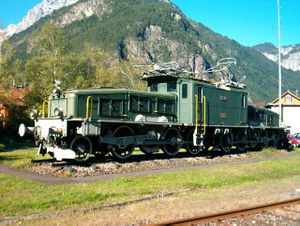Gotthardbahn
Gotthardbahn was the name of a private Swiss railway company which operated the railway line from Immensee (canton of Schwyz) to Chiasso (Italian border). Nowadays this term usually does not refer to that company, but to the railway line itself.
Contents
Construction
After the Semmering Railway, the Brenner Railway and the Mont-Cenis-Route the Gotthardbahn was the fourth railway line through the Alps. Construction started 1872 after long discussions about the best layout of the line and treaties with the Kingdom of Italy (1869) and the German Empire (1871). The first lowland sections Biasca-Giubiasco-Locarno and Lugano-Chiasso were opened by 1874.
The whole line was inaugurated with festivities in Lucerne and Chiasso from 21 May to 25 May 1882. Scheduled operation started on 1 June. At the time, the 15,003-meter-long Gotthard Rail Tunnel was the world's longest rail tunnel (seconded by the Simplon Tunnel in 1906). Soon after construction, the line was secured by the army with fortresses (for instance above Airolo and at Biasca) and ways to block the tunnel in case of an invasion (among others an artificial landslide to block the southern tunnel entrance).
At the same time the Aargauische Südbahn completed the section Rotkreuz-Immensse, which provided a rail link from Aarau to Arth-Goldau. The feeder lines to Lucerne and Zurich were completed in 1887.
In 1909, the Gotthardbahn was integrated into the network of the Swiss Federal Railways founded in 1902. The whole line was electrified with 15 kV alternating current (singe phase, 16 2/3 Hz) in 1922.
Route
Immensee - Erstfeld
Starting at Immensee, the line follows the Lake of Zug to Arth-Goldau (510 meters). Here the line from Lucerne joins and the Südostbahn route to Biberbrugg-Rapperswil/Einsiedeln branches; further, there is a connection to the Arth-Rigi-Bahn, a rack railway climbing the Rigi. Then it follows the Lauerzer See and passes Schwyz, the capital of the canton of Schwyz (455 meters). From Brunnen to Fluelen, the line follows the Vierwaldstätter See (that part of it is also referred to as Urnersee). In that section, the Axen, the two tracks are built separate due to space constraints. Erstfeld (472 meters) is finally reached via Altdorf, and the northern ramp begins.
Northern ramp, Erstfeld - Göschenen
The Erstfeld depot houses rolling stock needed for the Gotthard route, i.e. for banking service. A Ce 6/8 "crocodile" serves as a memorial for the legendary Gotthard locomotives.
The track now gets steeper with a gradient of up to 28‰. After Amsteg the line passes the Chärstelenbach bridge and changes the side of the Reuss valley over the Intschireuss bridge, which is, with its 77 meters, the highest bridge in the SBB network. After Gurtnellen (738 meters), the first spirals follow; their purpose is mainly to gain height where no space is available. Two of them form the double loop of Wassen (928 meters), which allows the famous church of Wassen to be seen three times from different perspectives, first from below and the last time 200 meters above. The line passes over the river Reuss three times in this section.
After yet another 1570-meter-long tunnel Göschenen (1106 meters) is reached, where passengers can take the train of the narrow gauge rack railway Matterhorn-Gotthard-Bahn (former Schöllenenbahn, Furka-Oberalp-Bahn) to Andermatt and from there over the Oberalppass to Chur or through the Furka Tunnel to Brig.
Gotthard Tunnel
The Gotthard Rail Tunnel is a 15,003-meter-long, double-track tunnel, built as one tube. The highest point of the Gotthard line is within this tunnel, 1151 meters above sea level. The tunnel crosses the border between the canton of Uri and the canton Ticino.

Southern ramp, Airolo - Biasca
After Airolo (1142 meters), the line crosses the river Ticino and descends through the valley Leventina. At Piotta, there is an 87.8% steep funicular railway to the Ritsom dam. Behind Rodi-Fiesso (942 meters), the most impressive section of the southern ramp begins. The valley narrows to the Piotta canyon, and the line passes two spirals ("Piottino-Loops") to lose 200 meters' height before reaching Faido. Two more spirals, known as the "Biaschina-Loops", lead the line down to Giornico (391 meters). The valley broadens and the line arrives at Biasca (293 meters).
Biasca - Bellinzona - Luino
From Biasca to Bellinzona (241 meters), the capital of the canton Ticino, the line follows the river Ticino. At Giubiasco, the line to Locarno and Luino branches. Originally the main line was the track to Luino, to connect the line with the Italian network and the Genoa port. Eventually, a second line over Monte Ceneri to Lugano, Como and Milan was also build for smaller and passenger only trains. For this reason the gradient on the Ceneri line is higher then the gradient of the Alp tracks.
Bellinzona - Chiasso
At Giubiasco, the line rises again to the Monte Ceneri and then passes through two parallel, single-track tunnels. It reaches the highest point on this part of the line, Rivera-Bironico, at 472 meters. Then it descends to Lugano at 335 meters.
Following the western waterside of the Lago di Lugano, the line arrives at Melide, where the Swissminiatur can be found, which shows Switzerland's best known tourist features at a 1:25 scale. The Lago di Lugano is crossed over an 817-meter-long bridge and dam and the track follows the eastern waterside to Capolago and Mendrisio. After over 200 kilometers the station Chiasso is reached, which houses the Italian customs and has a big international shunting yard. Conventional trains change locomotives here due to different traction voltages and automatic train protection systems in Italy.
Stock
Most of the Swiss locomotives were originally constructed for the Gotthard line, so many of them were called "Gotthardlokomotiven", for instance C 5/6 "Elephant", Ce 6/8 and Be 6/8 "Krokodil", Ae 8/14 "Landilok", Ae 6/6, Re 620. Famous trainsets on the Gotthard route are the Trans-Europe Express and the Rote Pfeil, as well as the tilting train Cisalpino Pendolino.
Nowadays passenger trains are mostly pulled by Re 4/4 II (up to two for long trains) and sometimes by Re 460, freight trains by Re 6/6 and Re 4/4 III. Up to 1300 tonns may be pulled by an Re 6/6 with an Re 4/4 III (this combination is sometimes referred to as Re 10/10); if the trains are heavier they have to be pushed by an additional Re 4/4 or Re 6/6, because the couplers are too weak to pull the entire train on the steep slopes.
Besides trains operated by the Swiss Federal Railways, other railway companies also run their trains on the Gotthard route since 2001 ("open access"). This includes, for instance, Cisalpino AG (Pendolino and ordinary passenger trains), Deutsche Bahn AG (mostly freight from Germany to Italy) and the Südostbahn (Voralpenexpress).
External links
- [1] Detailed description by Bruno Lämmli, in German



